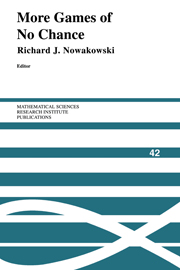Book contents
- Frontmatter
- Contents
- Preface
- The Big Picture
- Idempotents Among Partisan Games
- On the Lattice Structure of Finite Games
- More Infinite Games
- Alpha-Beta Pruning Under Partial Orders
- The Abstract Structure of the Group of Games
- The Old Classics
- Higher Nimbers in Pawn Endgames on Large Chessboards
- Restoring Fairness to Dukego
- Go Thermography: The 4/21/98 Jiang-Rui Endgame
- An Application of Mathematical Game Theory to Go Endgames: Some Width-Two-Entrance Rooms With and Without Kos
- Go Endgames Are PSPACE-Hard
- Global Threats in Combinatorial Games: A Computation Model with Applications to Chess Endgames
- The Game of Hex: The Hierarchical Approach
- Hypercube Tic-Tac-Toe
- Transfinite Chomp
- A Memory Efficient Retrograde Algorithm and Its Application to Chinese Chess Endgames
- The New Classics
- The 4G4G4G4G4 Problems and Solutions
- Experiments in Computer Amazons
- Exhaustive Search in Amazons
- Two-Player Games on Cellular Automata
- Who Wins Domineering on Rectangular Boards?
- Forcing Your Opponent to Stay in Control of a Loony Dot-and-Boxes Endgame
- 1 x n Konane: A Summary of Results
- 1-Dimensional Peg Solitaire, and Duotaire
- Phutball Endgames Are Hard
- One-Dimensional Phutball
- A Symmetric Strategy in Graph Avoidance Games
- A Simple FSM-Based Proof of the Additive Periodicity of the Sprague-Grundy Function of Wythoff's Game
- Puzzles and Life
- The Complexity of Clickomania
- Coin-Moving Puzzles
- Searching for Spaceships
- Surveys
- Unsolved Problems in Combinatorial Game Theory: Updated
- Combinatorial Games: Selected Bibliography With A Succinct Gourmet Introduction
Restoring Fairness to Dukego
Published online by Cambridge University Press: 29 May 2025
- Frontmatter
- Contents
- Preface
- The Big Picture
- Idempotents Among Partisan Games
- On the Lattice Structure of Finite Games
- More Infinite Games
- Alpha-Beta Pruning Under Partial Orders
- The Abstract Structure of the Group of Games
- The Old Classics
- Higher Nimbers in Pawn Endgames on Large Chessboards
- Restoring Fairness to Dukego
- Go Thermography: The 4/21/98 Jiang-Rui Endgame
- An Application of Mathematical Game Theory to Go Endgames: Some Width-Two-Entrance Rooms With and Without Kos
- Go Endgames Are PSPACE-Hard
- Global Threats in Combinatorial Games: A Computation Model with Applications to Chess Endgames
- The Game of Hex: The Hierarchical Approach
- Hypercube Tic-Tac-Toe
- Transfinite Chomp
- A Memory Efficient Retrograde Algorithm and Its Application to Chinese Chess Endgames
- The New Classics
- The 4G4G4G4G4 Problems and Solutions
- Experiments in Computer Amazons
- Exhaustive Search in Amazons
- Two-Player Games on Cellular Automata
- Who Wins Domineering on Rectangular Boards?
- Forcing Your Opponent to Stay in Control of a Loony Dot-and-Boxes Endgame
- 1 x n Konane: A Summary of Results
- 1-Dimensional Peg Solitaire, and Duotaire
- Phutball Endgames Are Hard
- One-Dimensional Phutball
- A Symmetric Strategy in Graph Avoidance Games
- A Simple FSM-Based Proof of the Additive Periodicity of the Sprague-Grundy Function of Wythoff's Game
- Puzzles and Life
- The Complexity of Clickomania
- Coin-Moving Puzzles
- Searching for Spaceships
- Surveys
- Unsolved Problems in Combinatorial Game Theory: Updated
- Combinatorial Games: Selected Bibliography With A Succinct Gourmet Introduction
Summary
ABSTRACT. In this paper we correct an analysis of the two-player perfect-information game Dukego given in Chapter 19 of Winning Ways. In particular, we characterize the board dimensions that are fair, i.e., those for which the first player to move has a winning strategy.
1. Introduction
The game of Quadraphage, invented by R. Epstein (see [3] and [4]), pits two players against each other on a (generalized) m x n chess board. The Chess player possesses a single chess piece such as a King or a Knight, which starts the game on the center square of the board (or as near as possible if mn is even); his object is to move his piece to any square on the edge of the board. The Go player possesses a large number of black stones, which she can play one per turn on any empty square to prevent the chess piece from moving there; her object is to block the chess piece so that it cannot move at all. (Thus the phrase “a large number” of black stones can be interpreted concretely as mn - 1 stones, enough to cover every square on the board other than the one occupied by the chess piece.) These games can also be called Chessgo, or indeed Kinggo, Knight go, etc. when referring to the game played with a specific chess piece.
Quadraphage can be played with non-conventional chess pieces as well; in fact, if we choose the chess piece to be an “angel” with the ability to fly to any square within a radius of 1000, we encounter J. Conway's infamous angel-vs.-devil game [2]. In this paper we consider the case where the chess piece is S. Golomb's Duke, a Fairy Chess piece that is more limited than a king, in that it moves one square per turn but only in a vertical or horizontal direction. In this game of Dukego, we will call the Chess player D and the Go player G.
Berlekamp, Conway, and Guy analyzed the game of Dukego in [1], drawing upon strategies developed by Golomb.
Information
- Type
- Chapter
- Information
- More Games of No Chance , pp. 79 - 88Publisher: Cambridge University PressPrint publication year: 2002
